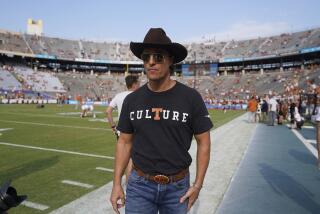Review: âDallas Buyers Clubâ led well by McConaughey, Leto
Few actors can play a grifter and a good olâ boy with the laid-back precision of Matthew McConaughey. Between the sidewinder glances, the sardonic grin and that slippery Texas drawl, he uses irony, edge and considerable charm to move us into taking his most questionable characters seriously, while we forgive their indiscretions.
McConaughey needs all of those substantial powers of persuasion for the gutsy, gritty âDallas Buyers Club.â He portrays a hard-bitten, hard-drinking, homophobic Texas redneck named Ron Woodroof, who becomes an unlikely warrior on the front lines of AIDS. Jared Leto as Rayon, a willowy transsexual who favors hot-pink lipstick, plunging necklines and heels, matches him biting aside for aside. Together they elevate the movie beyond ordinary biography or overplayed tragedy, and give Oscar-worthy performances in the process.
Directed with an unsentimental hand by Jean-Marc VallĂŠe, from Craig Borten and Melisa Wallackâs smart screenplay, this cut at the AIDS crisis is marked by unexpected humor and roughneck rebellion as well as heart-wrenching humanity. A feverish film, it often mirrors the opening and closing scenes â a rodeo cowboy on the back of an angry bull. Even with some flaws and flailing, âDallas Buyers Clubâ is a rough, raw, ragged and exhilarating ride.
RELATED: More movie reviews by The Times
The movie follows Woodroof from his HIV diagnosis in 1985 to his death seven years later â long past the 30 days the doctors first gave him. In Ron, the filmmakers have the ideal embodiment of macho outrage. In real life, Woodroof used it to fuel his fight against disease and the FDA, which expended a great deal of energy to slow approval and shut down access to experimental drugs, even as the death toll mounted. Besides AIDS, the agency is the filmâs primary enemy. Much of the movieâs conflict is linked to Woodroofâs confrontations with FDA official Richard Barkley (Michael OâNeill), both trying to outmaneuver the other.
But Ronâs anti-gay bias serves another purpose. The film uses his paranoia to expose the raw nerves of the country circa 1985, when fear of accidentally contracting HIV ran high and misconceptions about homosexuality were rampant. It is telling that when his doctors â Dr. Sevard (Denis OâHare) and key researcher Eve (Jennifer Garner) â diagnose HIV, the panic and anger that follow are bound up in Woodroofâs fear that someone might think he is gay.
Though the films opens with a death sentence â Woodroof apparently contracted the virus from unprotected sex with a main-lining hooker â âDallas Buyers Clubâ is really about beating the odds. Woodroof is determined to find, use and also sell the most promising AIDS cocktails. The search for the latest meds takes him from Mexico to Japan to Germany, with the authorities â the DEA and IRS joining the FDA â nipping at his heels. Their skirmishes put on trial Big Pharmaâs role in the development and distribution of AIDS drugs, and the FDAâs red tape and glacial pace.
VIDEO: Southern drawls on film
The human story is the more interesting one.
HIV does not turn Woodroof into the understanding type, not even when lifelong friends desert and ridicule him. What ultimately softens Woodroof is Rayon. They meet in the hospitalâs AIDS ward. Their relationship begins as a testy business arrangement, a way for Woodroof to sell bootlegged AZT to the gay community. That leads to the creation of the Dallas Buyers Club, where a $400 membership comes with a monthâs supply of medication.
Over time, their bond evolves into a real friendship that somehow exists alongside the biases Woodroof canât quite let go. Itâs a credit to both actors how well they walk the love-hate line.
To play a dying man, McConaughey dropped enough weight to look as if he is at deathâs door, as did Leto. Both are gaunt, with McConaugheyâs weight loss so extreme as to border on distraction. But itâs not the exterior that makes the man. McConaughey channels the spirit of a revolutionary and the soul of a redneck in what is one of his most affecting performances yet. Itâs been a good year for the actor, with another star turn as a backwoods romantic on the run in âMud.â With âDallas,â he continues to shift from rom-com light to serious, significant roles.
PHOTOS: Fall movie sneaks 2013
Letoâs performance, though, is the revelation. Heâs tended to be more of an ensemble player in films like 1998âs âThe Thin Red Lineâ or 2000âs âRequiem for a Dream.â His starring roles have come in overlooked indies like âMr. Nobodyâ in 2009, âChapter 27â in 2007. Rayon should change all that. Itâs a hauntingly authentic performance; the tailored suit he puts on to meet with his disapproving father is one of the filmâs most moving scenes.
The difficulties in âDallasâ exist around the edges. Garner is once again cast as a quintessentially decent, all-American girl, albeit a doctor. But the question of whether the actress has deeper emotional layers to bring to the screen is not answered here.
Meanwhile, VallĂŠe lets the bureaucratic bad guys played by OâNeill and OâHare, whose doc is desperate to keep his clinical trials going, get far too close to parody. Compared to the French Canadian directorâs earlier work â whether his 2005 dramatic take on love in the well-received âC.R.A.Z.Yâ or the romantic drama of 2009âs âThe Young Victoriaâ â âDallas Buyers Clubâ is by far his most challenging film. And though it represents a career high, at times it gets the best of him.
Ultimately, the movieâs strength lies in the performances of McConaughey and Leto. The actors bring a kind of flinty resilience to their characters despite a relentless disease and an irreversible fate. Not always easy to witness, impossible to forget.
------------------------------
âDallas Buyers Clubâ
MPAA rating: R for pervasive language, some strong sexual content, nudity and drug use
Running time: 1 hour, 57 minutes
Playing: ArcLight Hollywood; AMC Century City; Landmark Theatre, West Los Angeles
More to Read
Only good movies
Get the Indie Focus newsletter, Mark Olsen's weekly guide to the world of cinema.
You may occasionally receive promotional content from the Los Angeles Times.











